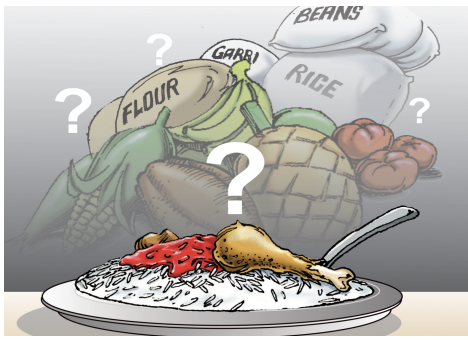
The growing number of hungry Nigerians, according to the latest Cadre Harmonisé analysis on national food insecurity, “is driven by the lingering insecurity which is driving high levels of agricultural livelihood disruptions and losses, abnormal spikes in food prices, soaring inflation rates, unstable Consumer Price Index rate increase, dollar-naira exchange depreciation rate, petroleum product subsidies removal and its negative consequences on transportation and overall living cost.” As of June, the number of Nigerians grappling with food insecurity had reached a whopping 31 million. “Unless targeted humanitarian actions in the forms of food assistance, emergency agricultural support and resilience livelihood re-building interventions are urgently implemented among the risk populations, their FNI situation may deteriorate further,” the report stated.
The United Nations World Food Programme (UNWFP) has warned repeatedly that millions of Nigerians are at the risk of hunger as prices of foodstuff skyrocket. Recent data compiled by an international e-commerce organisation also revealed that the average Nigerian household spends about 60 per cent of its income on food, the highest in the world. Insecurity in many of the rural communities has made it practically difficult for farmers to engage in agricultural production optimally, thus affecting productivity and largely causing market disruptions with attendant food price shocks.
For years, the cost of the general insecurity, particularly in the north has adversely affected agricultural production and cost of living. Staples such as beans and tomatoes have seen astronomical surge in prices, just like onions, and cassava flour. Some states with high food prices are ironically major food-producing belt in peace times. Sokoto, for instance, is a major producer of beans, cowpea, groundnut, garlic, wheat, sugarcane, pepper, onions, and tomatoes, while groundnut, sorghum, sesame seed, maize, potatoes, tomatoes, onions, and pepper are produced extensively in Plateau State.
With the support of the federal government and the United Nations (UN) systems, the Cadre Harmonisé, an initiative focused on food and nutrition analysis, conducts studies biannually (in March and October) across 26 states and the Federal Capital Territory (FCT). “Food insecurity and malnutrition are among the main drivers of humanitarian need in the BAY (Borno, Adamawa, and Yobe) states,” said the head of the Office for the Coordination of Humanitarian Affairs (OCHA) in Nigeria, Trond Jensen. “People have been forced to adopt negative coping mechanisms such as survival sex and child labour to stay alive. Over the past year, dozens of farmers have lost their lives, and others have been abducted or injured while eking out a living outside the security perimeters of Borno’s garrison towns due to limited farming lands and few or no livelihood options.”
While urging federal and state governments in Nigeria, donors, and other stakeholders to commit resources and implement measures to avert a potential food and nutrition disaster, the UN warns that timely action is of essence. According to the World Food Programme (WFP) Country Representative, David Stevenson, the hunger crisis in Nigeria, fuelled by the ongoing conflict in the northeast, needs urgent addressing. “Restoring peace in the northeast is critical for us to build pathways to production and achieve the northeast’s potential as the food basket of the country”, he said.
Since food is needed for survival and well-being, there is a need for urgent intervention to avert a human catastrophe in the country. With the fear of malnutrition for millions of children (and mothers) who are deprived of a healthy and productive life, the situation is already dire. The recent flooding in several communities across the country has only compounded the woes of millions of Nigerians. We therefore enjoin authorities at all levels in the country to come up with practical solutions to the challenge of food security in Nigeria.
END

Be the first to comment